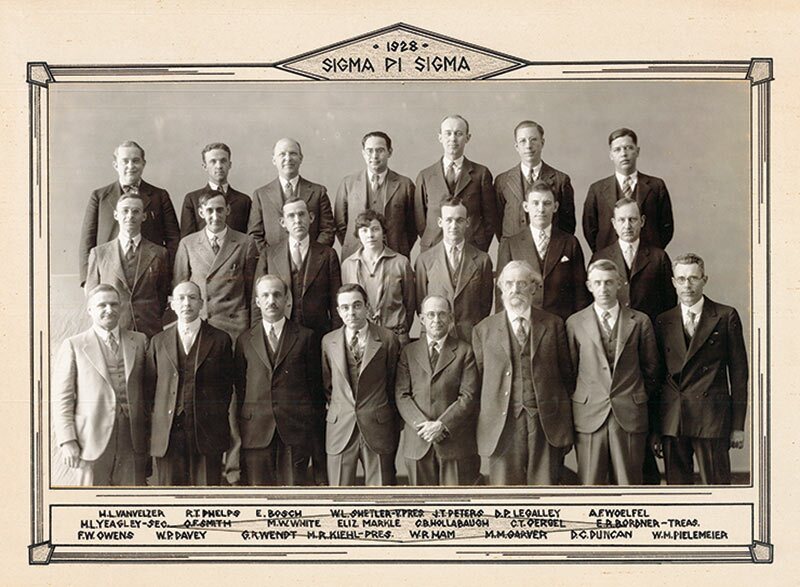Sigma Pi Sigma – A Departmental Legacy of Fellowship

Sigma Pi Sigma leadership from 1928. Picture from M. White personal records.
What we know today as Sigma Pi Sigma and the Society of Physics Students began back in 1920 at Davidson College, North Carolina, when four students and five physics department faculty members formed an organization to
. . . reward high scholarship and promote interest in the advanced study of Physics, to stimulate individual research, to enable its members to keep pace with the progress of the science, and to encourage a spirit of co-operation and friendship among those who have displayed marked ability in this study.1
A formal decision to create such a fraternity was finalized on December 21, 1921, but it was immediately apparent to the founding members that they were different than a “social fraternity of the conventional kind.”1 The organization immediately became a vehicle for change within the department, gave opportunities for individual student and faculty expression, and let its members “talk shop” informally and freely through seminars and friendly gatherings outside the department. While there was a social component to the fraternity, as was customary at the time, the primary focus was on forming a physics-related professional community through shared meals, scholarship, and development of the department. Discussion topics ranged from social to science—from physics, to astronomy, to what would become several different physical sciences as we know them today. The group aimed to be “an active factor in the life” of its members.1
While it may seem that physics departments, and indeed, physics students, must be vastly different today than they were in 1921, an article from the December 1931 issue of The Radiations of Sigma Pi Sigma suggests otherwise.2 That issue highlighted the 10th anniversary of the organization and gave an intimate view into the first meetings of the first Sigma Pi Sigma chapter, or the alpha chapter. L. M. Curie, a founding member, tells Radiations readers,
From such a modest beginning, the present organization of Sigma Pi Sigma has grown. From this beginning, however, interest in physics at Davidson has shown a steady increase. The most serious subject for consideration at the first business meeting after organization was a discussion by Price, Brice, and Dew (founding members) as to how much voltage could be applied to “Wooly” Grey (a member of the first group initiated into the chapter in 1922) without doing him any permanent injury. A moderate voltage was decided upon and applied at a later date.
I don’t know if your classmates were anything like mine, but this would have fit right in with discussions we had at my chapter at the Rochester Institute of Technology almost 80 years later. In fact, the last time I hosted an induction at Appalachian State University, we made a pun in this vein about giving “the charge” to new Sigma Pi Sigma members.
Curie goes on to write,
It seems somewhat the irony of fate that among my first efforts for the good of the cause should have been a paper which I presented to the group sometime during the first year. This paper dealt with dry cells and primary batteries in general. As a punishment for that effort, I have spent the last six years finding out that two-thirds of what I said in my first paper was not true—and I have as yet been unable to find out the reason for the truth of the 33-1/3 percent.

The first public symbol of the organization, a pledge badge, was a horseshoe magnet and was adopted2 on February 22, 1922. Excellence in physics was stressed from the beginning, as members of the first class to be inducted into Sigma Pi Sigma
It was decided that Sigma Pi Sigma should become a national organization, and on April 12, 1925, a modest expansion program began. A second chapter of Sigma Pi Sigma was chartered at Duke University that spring and a third chapter at the Pennsylvania State University the following academic year. The first national convention of the society was held in 1928, with all six chapters participating. During this period of time, questions of governance, the constitution, and requirements were adjusted to more closely resemble what we know today. Of great debate was the requirements for chapter activity. Ultimately, it was decided that while no formal requirement for regular meetings or activities needed to be specified, chapters should be ingrained within the department culture, faculty and students alike. Early discussions stressed that membership within the society was regarded as an honor to strive for, yet it was well understood that the chapter should benefit the entire department, so much so that it was decided by the 1928 convention to actively promote the concept and vision of Sigma Pi Sigma to colleagues and other institutions. This resulted in rapid expansion, and by June 2, 1930, there were 19 chapters, with 9 of the chapters being installed in 19 days!
Over the following decades, Sigma Pi Sigma continued to grow and respond to the needs of new generations of physical scientists. Through the early support of Marsh White and several other societies, including the American Association for the Advancement of Science, the American Association of Physics Teachers, and the American Institute of Physics, Sigma Pi Sigma has grown to represent hundreds of departments and continues to serve the needs of students, faculty, and the broader community.
1. “Nine Years of Lusty Growth: Visions of Founders of Local Honorary at Davidson College far Surpassed by Substantial Development of Recent Years — A Story of Achievement,” The Radiations of Sigma Pi Sigma, October 1930.
2. L. M. Curie, “Letter from Our Founders,” reprinted from the December 1931 issue of The Radiations of Sigma Pi Sigma, p. 1.




